The packaging tubes market stands at the threshold of a decade-long expansion trajectory that promises to reshape cylindrical packaging technology and product protection solutions. The market's journey from USD 6.2 billion in 2025 to USD 11.8 billion by 2035 represents substantial growth, demonstrating the accelerating adoption of advanced tube manufacturing technology and premium packaging optimization across cosmetics, pharmaceuticals, food & beverage, and industrial application sectors.
The first half of the decade (2025 to 2030) will witness the market climbing from USD 6.2 billion to approximately USD 8.1 billion, adding USD 1.9 billion in value, which constitutes 34% of the total forecast growth period. This phase will be characterized by the rapid adoption of premium tube products, driven by increasing beauty and personal care consumption and the growing need for advanced barrier protection solutions worldwide. Enhanced moisture resistance capabilities and tamper-evident systems will become standard expectations rather than premium options.
The latter half (2030 to 2035) will witness continued growth from USD 8.1 billion to USD 11.8 billion, representing an addition of USD 3.7 billion or 66% of the decade's expansion. This period will be defined by mass market penetration of specialized barrier technologies, integration with comprehensive smart packaging platforms, and seamless compatibility with existing manufacturing infrastructure. The market trajectory signals fundamental shifts in how brands approach packaging durability and product protection management, with participants positioned to benefit from growing demand across multiple tube types and application segments.
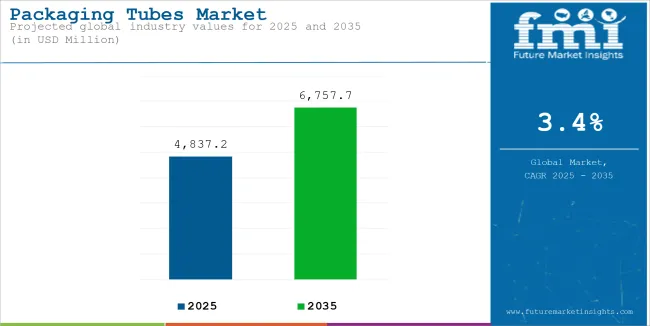
| Period | Primary Revenue Buckets | Share | Notes |
|---|---|---|---|
| Today | Laminated tubes (multi-layer) | 38% | Cosmetics, pharmaceuticals, premium protection |
| Plastic tubes (PE/PP) | 31% | Food products, industrial applications | |
| Aluminum tubes | 19% | High-end cosmetics, medical products | |
| Paper tubes | 12% | Eco-friendly packaging, lightweight products | |
| Future (3-5 yrs) | Smart barrier laminated tubes | 35-42% | IoT integration, freshness monitoring |
| Recyclable plastic tubes | 28-33% | Circular economy, brand commitments | |
| Premium aluminum tubes | 18-23% | Luxury positioning, barrier excellence | |
| Bio-based composite tubes | 12-18% | Environmental regulations, plant-based materials | |
| Refillable tube systems | 5-8% | Circular packaging, consumer reuse |
At-a-Glance Metrics
| Metric | Value |
|---|---|
| Market Value (2025) | USD 6.2 billion |
| Market Forecast (2035) | USD 11.8 billion |
| Growth Rate | 6.6% CAGR |
| Leading Technology | Laminated Tubes |
| Primary Application | Cosmetics & Personal Care Segment |
The market demonstrates strong fundamentals with laminated tube systems capturing a dominant share through advanced barrier capabilities and product protection optimization. Cosmetics and personal care applications drive primary demand, supported by increasing beauty consumption and premium packaging equipment adoption requirements. Geographic expansion remains concentrated in developed markets with established beauty cultures, while emerging economies show accelerating adoption rates driven by brand proliferation and rising quality standards.
Primary Classification: The market segments by tube type into laminated tubes, plastic tubes, aluminum tubes, and paper tubes, representing the evolution from basic packaging materials to sophisticated barrier solutions for comprehensive product protection optimization.
Secondary Classification: Capacity segmentation divides the market into small tubes (up to 50ml), medium tubes (50-150ml), large tubes (150-300ml), and extra-large tubes (above 300ml), reflecting distinct requirements for product volume, application method, and consumer usage standards.
Tertiary Classification: Application segmentation covers cosmetics & personal care, pharmaceuticals, food & beverage, industrial applications, and household products, while material composition spans laminated structures, plastic resins, aluminum alloys, and paper-based composites.
Regional Classification: Geographic distribution covers North America, Latin America, Western Europe, Eastern Europe, East Asia, South Asia Pacific, and Middle East & Africa, with developed markets leading adoption while emerging economies show accelerating growth patterns driven by beauty market expansion programs.
The segmentation structure reveals technology progression from standard packaging materials toward sophisticated barrier systems with enhanced protection and tamper-evident capabilities, while application diversity spans from cosmetics operations to pharmaceutical establishments requiring precise dispensing solutions.
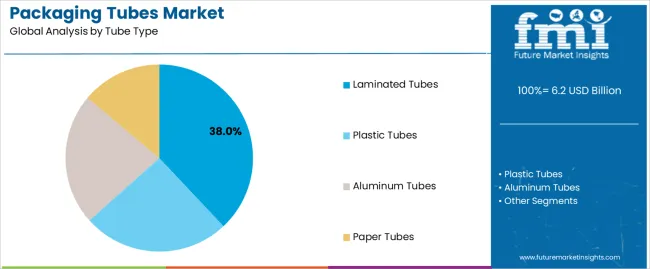
Market Position: Laminated Tube systems command the leading position in the packaging tubes market with 38% market share through advanced barrier features, including superior moisture protection, oxygen resistance, and product compatibility optimization that enable manufacturers to achieve optimal product preservation across diverse cosmetic and pharmaceutical environments.
Value Drivers: The segment benefits from brand preference for reliable barrier systems that provide consistent protection performance, enhanced product stability, and quality optimization without compromising tube flexibility or affecting dispensing characteristics. Advanced lamination technology enables multi-layer construction, visual appeal, and integration with existing filling equipment, where barrier performance and decoration compatibility represent critical operational requirements.
Competitive Advantages: Laminated Tube systems differentiate through proven barrier reliability, consistent protection characteristics, and integration with automated filling systems that enhance operational efficiency while maintaining optimal product stability standards suitable for diverse cosmetic and pharmaceutical applications.
Key market characteristics:
Plastic Tube systems maintain a 31% market position in the packaging tubes market due to their cost-effectiveness and processing advantages. These systems appeal to manufacturers requiring efficient filling operations with competitive pricing for diverse product packaging applications. Market growth is driven by operator preference, emphasizing operational efficiency and versatile packaging through optimized tube design.
Aluminum Tube systems capture 19% market share through premium barrier requirements in high-end cosmetics, pharmaceutical products, and specialty applications. These manufacturers demand superior protection systems capable of handling sensitive formulations while providing exceptional product integrity and brand presentation.
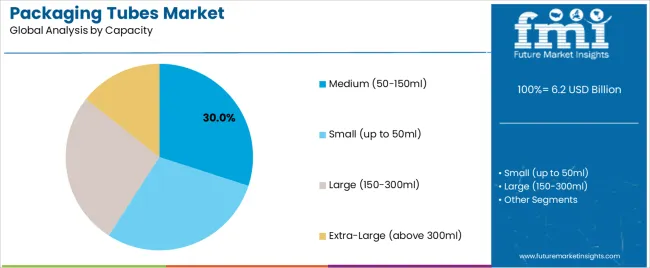
Market Context: Medium capacity tubes (50-150ml) are showing the highest growth rate in the packaging tubes market, accounting for a 30% share. This is driven by the growing demand for family-sized products, along with a focus on multi-use packaging, enhanced product optimization, and consumer convenience optimizing value while ensuring portability.
Appeal Factors: Medium tube operators prioritize product capacity, dispensing efficiency, and integration with diverse formulation types that enables optimized packaging operations across multiple product sizes. The segment benefits from substantial beauty industry investment and consumer convenience programs that emphasize the acquisition of medium tubes for product optimization and usage applications.
Growth Drivers: Beauty market expansion programs incorporate medium tubes as standard packaging for family products, while brand growth increases demand for versatile capacity capabilities that comply with consumer preferences and minimize packaging complexity.
Market Challenges: Varying product viscosities and formulation compatibility may limit tube standardization across different brands or application scenarios.
Application dynamics include:
Small capacity tube applications capture market share through travel-size requirements in cosmetics, sample packaging, and single-use products. These applications demand compact packaging systems capable of operating with high-speed equipment while providing effective product protection and dispensing simplicity capabilities.
Large capacity tube applications account for market share, including industrial products, bulk formulations, and high-volume packaging requiring substantial capacity capabilities for operational optimization and cost efficiency.
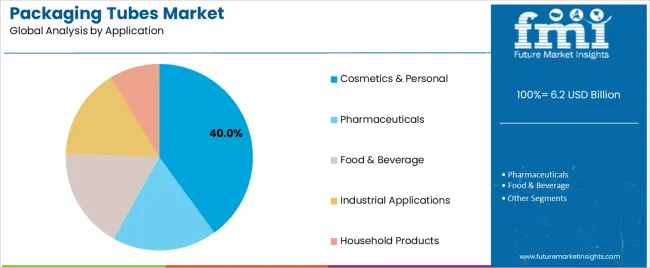
Market Position: Cosmetics & Personal Care applications hold a significant market position, commanding a 40% share. This is driven by rising beauty consumption trends and the adoption of premium products for advanced skincare delivery.
Value Drivers: This application segment provides the ideal combination of protection and presentation, meeting requirements for product preservation, brand visibility, and consumer convenience without reliance on secondary packaging.
Growth Characteristics: The segment benefits from broad applicability across beauty brands, premium packaging adoption, and established distribution programs that support widespread tube usage and brand differentiation.
| Category | Factor | Impact | Why It Matters |
|---|---|---|---|
| Driver | Beauty & personal care boom & premium product trends (skincare innovation, anti-aging products) | ★★★★★ | Exponential growth in beauty consumption creates massive demand for premium packaging; quality-driven consumer behavior drives market expansion. |
| Driver | Pharmaceutical packaging requirements & drug delivery innovation | ★★★★★ | Rapid growth in topical medications and specialized formulations; standardized barrier requirements across multiple products drive bulk procurement and consistent demand. |
| Driver | Barrier technology advancement & product protection needs (oxygen barriers, moisture resistance) | ★★★★★ | Technical innovation enabling superior product preservation; advanced barrier systems become mandatory for premium formulations and extended shelf-life requirements. |
| Restraint | Competition from alternative packaging formats & pump dispensers | ★★★☆☆ | Growing adoption of airless systems and pump mechanisms in select markets; premium dispensing technology creates substitution pressure for traditional tubes. |
| Restraint | Raw material cost volatility & resin price fluctuations | ★★★★☆ | Aluminum and plastic resin price variations impact profit margins; commodity nature of basic tubes constrains pricing power during cost increases. |
| Trend | Smart packaging integration & IoT-enabled tubes (freshness sensors, usage tracking) | ★★★★★ | Brands leveraging technology for consumer engagement; connected packaging drives premium tube adoption for data collection and brand interaction. |
| Trend | Recyclable & refillable tube systems (circular economy models, zero-waste initiatives) | ★★★★☆ | Environmental consciousness driving packaging innovation; closed-loop systems replacing traditional single-use models for brand differentiation. |
The packaging tubes market demonstrates varied regional dynamics with Growth Leaders including China (8.9% growth rate) and India (9.1% growth rate) driving expansion through beauty market proliferation and consumer product growth initiatives. Steady Performers encompass United States (6.4% growth rate), Germany (6.7% growth rate), and developed regions, benefiting from established beauty cultures and premium packaging adoption. Emerging Markets feature Brazil (8.3% growth rate) and developing regions, where cosmetics expansion and packaging modernization support consistent growth patterns.
Regional synthesis reveals North American markets leading value generation through premium product adoption and luxury packaging culture, while Asian markets demonstrate highest volume growth supported by beauty market proliferation and rising consumer spending trends. European markets show moderate growth driven by regulatory packaging requirements and quality enhancement integration.
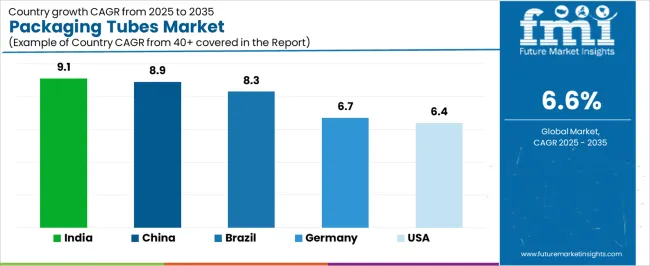
| Region/Country | 2025 to 2035 Growth | How to win | What to watch out |
|---|---|---|---|
| China | 8.9% | Beauty market scale; cost-effective premium solutions | Quality inconsistency; local competition |
| India | 9.1% | Consumer product expansion; affordable premium tubes | Infrastructure gaps; distribution challenges |
| United States | 6.4% | Luxury positioning; barrier innovation | Regulatory complexity; margin pressure |
| Germany | 6.7% | Engineering excellence; premium positioning | Economic volatility; cost sensitivities |
| Brazil | 8.3% | Beauty market growth; regional partnerships | Economic instability; logistics constraints |
China establishes fastest market growth through massive beauty industry infrastructure and comprehensive consumer product development, integrating advanced packaging tubes as standard components in cosmetic operations and personal care installations. The country's 8.9% growth rate reflects explosive beauty consumption adoption and domestic manufacturing industry expansion that mandates the use of quality packaging systems in cosmetic and pharmaceutical facilities. Growth concentrates in major urban centers, including Shanghai, Beijing, and Shenzhen, where beauty brands showcase integrated packaging systems that appeal to manufacturers seeking advanced barrier capabilities and production optimization applications.
Chinese manufacturers are developing domestically-produced tube solutions that combine local production advantages with functional operational features, including enhanced barrier resistance and decoration capabilities. Distribution channels through beauty supply chains and manufacturing partnerships expand market access, while consumer culture supports adoption across diverse cosmetic and personal care segments.
Strategic Market Indicators:
In Mumbai, Delhi, and Bangalore, cosmetic brands and personal care manufacturers are implementing packaging tubes as standard containers for product protection and brand presentation applications, driven by increasing beauty investment and consumer spending programs that emphasize the importance of packaging quality. The market holds a 9.1% growth rate, supported by consumer product expansion and urbanization programs that promote quality tube systems for cosmetic and pharmaceutical applications. Indian operators are adopting tube solutions that provide consistent barrier performance and decoration features, particularly appealing in urban regions where beauty products and packaging quality represent critical consumer expectations.
Market expansion benefits from growing middle-class consumption patterns and beauty brand proliferation that enable widespread adoption of quality packaging systems for cosmetic and personal care applications. Technology adoption follows patterns established in consumer goods packaging, where functionality and value drive procurement decisions and operational deployment.
Market Intelligence Brief:
United States establishes market leadership through comprehensive beauty programs and advanced packaging culture development, integrating packaging tubes across cosmetic and pharmaceutical applications. The country's 6.4% growth rate reflects established premium consumption patterns and mature packaging technology adoption that supports widespread use of barrier tube systems in beauty and pharmaceutical facilities. Growth concentrates in major metropolitan areas, including New York, Los Angeles, and Chicago, where beauty culture showcases mature tube deployment that appeals to brand operators seeking proven barrier capabilities and presentation applications.
American cosmetic manufacturers leverage established distribution networks and comprehensive product availability, including custom-decorated tubes and barrier-enhanced options that create brand differentiation and operational advantages. The market benefits from mature beauty infrastructure and consumer willingness to invest in quality packaging materials that enhance product experience and presentation optimization.
Market Intelligence Brief:
Advanced manufacturing market in Germany demonstrates sophisticated packaging tube deployment with documented engineering effectiveness in cosmetic applications and pharmaceutical facilities through integration with existing production systems and quality infrastructure. The country leverages precision manufacturing and quality standards to maintain a 6.7% growth rate. Industrial centers, including Munich, Hamburg, and Stuttgart, showcase premium installations where packaging tubes integrate with comprehensive production platforms and quality systems to optimize barrier operations and manufacturing effectiveness.
German operators prioritize packaging precision and technical excellence in tube procurement, creating demand for engineered products with advanced features, including precise dispensing systems and barrier certifications. The market benefits from established engineering consciousness and a willingness to invest in premium packaging materials that provide superior performance benefits and adherence to quality standards.
Market Intelligence Brief:
Packaging tubes market expansion in Brazil benefits from diverse beauty demand, including cosmetic expansion in São Paulo and Rio de Janeiro, brand establishment growth, and rising consumer spending that increasingly incorporate tube solutions for product packaging applications. The country maintains an 8.3% growth rate, driven by urbanization and increasing recognition of tube benefits, including improved product protection and enhanced brand presentation.
Market dynamics focus on affordable quality tube solutions that balance packaging performance with cost considerations important to Brazilian cosmetic operators. Growing beauty market proliferation creates continued demand for modern packaging systems in new brand infrastructure and product modernization projects.
Strategic Market Considerations:
The European packaging tubes market is projected to grow from USD 2.1 billion in 2025 to USD 3.6 billion by 2035, registering a CAGR of 5.5% over the forecast period. Germany is expected to maintain its leadership position with a 31.2% market share in 2025, supported by its strong manufacturing base and premium cosmetics industry.
France follows with a 24.8% share in 2025, driven by luxury beauty brands and premium packaging culture. United Kingdom holds a 19.6% share through established beauty market and packaging innovation. Italy commands a 13.7% share, while Spain accounts for 10.7% in 2025. The rest of Europe region is anticipated to gain momentum, expanding its collective share from 7.3% to 8.2% by 2035, attributed to increasing beauty consumption in Nordic countries and emerging cosmetic brands implementing quality packaging programs.
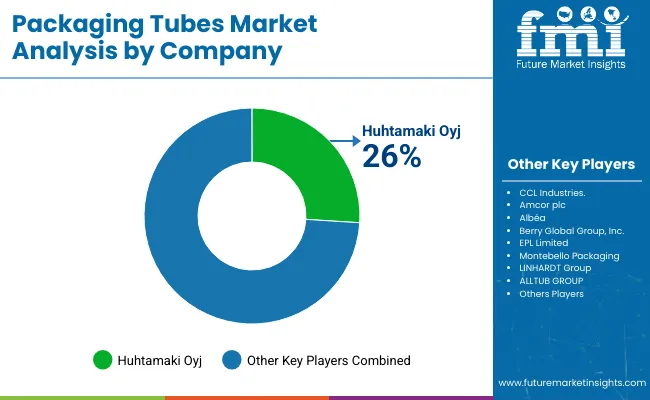
| Stakeholder | What they actually control | Typical strengths | Typical blind spots |
|---|---|---|---|
| Global manufacturers | Production capacity, barrier technology, distribution networks | Scale efficiency, consistent quality, broad reach | Innovation speed; local customization |
| Specialty converters | Custom decoration; barrier technology; premium designs | Quality leadership; brand partnerships; differentiation | Mass market penetration; price competition |
| Regional producers | Local manufacturing, distribution channels, competitive pricing | Market proximity; cultural understanding; cost advantage | Technology gaps; international expansion |
| Private label suppliers | Brand partnerships, value positioning, volume production | Price competitiveness; retail access; volume scale | Brand loyalty; premium segment access |
| Technology innovators | Barrier technology, smart packaging, material science | Technical expertise; patent portfolio; performance | Market scalability; distribution challenges |
| Item | Value |
|---|---|
| Quantitative Units | USD 6.2 billion |
| Tube Type | Laminated Tubes, Plastic Tubes, Aluminum Tubes, Paper Tubes |
| Capacity | Small (up to 50ml), Medium (50-150ml), Large (150-300ml), Extra-Large (above 300ml) |
| Material Composition | Laminated Structures, Plastic Resins, Aluminum Alloys, Paper-Based Composites |
| Application | Cosmetics & Personal Care, Pharmaceuticals, Food & Beverage, Industrial Applications, Household Products |
| Regions Covered | North America, Latin America, Western Europe, Eastern Europe, East Asia, South Asia Pacific, Middle East & Africa |
| Countries Covered | United States, China, Germany, India, France, Brazil, Canada, Japan, United Kingdom, Italy, and 35+ additional countries |
| Key Companies Profiled | Sonoco Products Company, CCL Industries Inc., Huhtamaki Oyj, Essel Propack Limited, Albea Group, Hoffmann Neopac AG, Montebello Packaging |
| Additional Attributes | Dollar sales by tube type and capacity categories, regional adoption trends across North America, East Asia, and Western Europe, competitive landscape with packaging manufacturers and brand suppliers, consumer preferences for product protection and brand presentation, integration with filling systems and manufacturing processes, innovations in barrier technology and smart packaging, and development of recyclable tube solutions with enhanced performance and environmental benefits. |
The global packaging tubes market is estimated to be valued at USD 6.2 billion in 2025.
The market size for the packaging tubes market is projected to reach USD 11.8 billion by 2035.
The packaging tubes market is expected to grow at a 6.6% CAGR between 2025 and 2035.
The key product types in packaging tubes market are laminated tubes, plastic tubes, aluminum tubes and paper tubes.
In terms of capacity, medium (50-150ml) segment to command 30.0% share in the packaging tubes market in 2025.






Full Research Suite comprises of:
Market outlook & trends analysis
Interviews & case studies
Strategic recommendations
Vendor profiles & capabilities analysis
5-year forecasts
8 regions and 60+ country-level data splits
Market segment data splits
12 months of continuous data updates
DELIVERED AS:
PDF EXCEL ONLINE
Market Share Insights of Leading Packaging Tube Providers
Packaging Testing Services Market Size and Share Forecast Outlook 2025 to 2035
Packaging Jar Market Forecast and Outlook 2025 to 2035
Packaging Barrier Film Market Size and Share Forecast Outlook 2025 to 2035
Packaging Films Market Size and Share Forecast Outlook 2025 to 2035
Packaging Laminate Market Size and Share Forecast Outlook 2025 to 2035
Packaging Burst Strength Test Market Size and Share Forecast Outlook 2025 to 2035
Packaging Tapes Market Analysis - Size, Share, & Forecast Outlook 2025 to 2035
Packaging Materials Market Size and Share Forecast Outlook 2025 to 2035
Packaging Labels Market Size and Share Forecast Outlook 2025 to 2035
Packaging Equipment Market Size and Share Forecast Outlook 2025 to 2035
Packaging Resins Market Size and Share Forecast Outlook 2025 to 2035
Packaging Inspection Systems Market Size and Share Forecast Outlook 2025 to 2035
Packaging Design And Simulation Technology Market Size and Share Forecast Outlook 2025 to 2035
Packaging Suction Cups Market Size and Share Forecast Outlook 2025 to 2035
Packaging Straps and Buckles Market Size and Share Forecast Outlook 2025 to 2035
Packaging Coating Market Analysis - Size, Share, & Forecast Outlook 2025 to 2035
Packaging Testing Equipment Market Analysis & Growth 2025 to 2035
Packaging Bins Market Trends - Growth & Demand 2025 to 2035
Packaging Inserts Market Insights - Growth & Forecast 2025 to 2035

Thank you!
You will receive an email from our Business Development Manager. Please be sure to check your SPAM/JUNK folder too.
Chat With
MaRIA